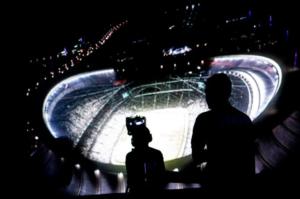Qatar cooling the heat on 2022
The World Cup is eight years away but planning has begun, including how to cope with the summer heat.

Doha, Qatar – The 2022 World Cup to be held in Qatar has faced a lot of criticism – allegations of corruption in the bidding process and countering the summer heat being the two main angles that critics have deployed.
While the former is under investigation by FIFA – and Qatar officials continue to deny all allegations – the latter is an issue being looked upon carefully by the Supreme Committee. Average temperature in Qatar during June and Jul (the World Cup months) remains in excess of 40C.
Keep reading
list of 4 itemsHolders Man City go out of Champions League on penalties to Real Madrid
Barca crash out as Mbappe brace leads PSG to Champions League last four
Saudi reviews football fan rules after whip attack
The organisers are testing the cooling technology that will be employed at all stadiums in 2022 at a Brazil 2014 fan-zone – at cost of QAR27m ($7.4m). Although no on the same scale as a stadium in the summer heat, the technology and the prototype are part of the development plan at every stadium.
Al Jazeera caught up with Tamim El Abed, the Qatar 2022 Technical Project Manager, to get some more details.
AJ: Tell us how this cooling technology will work?
TA: The process employs fresh air handling units that draw ambient air from the exterior of the venue. It will reduce the temperature of that air through chilled water pipes and then distribute it around the venue through subtly concealed outlets.
AJ: The situation will be different to this fan-zone. How will that affect planning and cooling?
TA: There have been cooled stadiums in the past. The difference here is cooling stadiums in Doha, these are unprecedented conditions. Apart from the cooled air, we will look at optimising wall height and roof-opening size as well. Obviously it will be an open-roof event but we will design the stadium from outside in such a way that it keeps hot air out. This will ensure the level of cooling on the field remains at a certain temperature and certain depth to ensure players are encompassed by a comfortable atmosphere all the time.
The process will also involve outlets projecting cold air at various velocities towards the field of play. We will optimise and maximise the use of shade as well as the optimising the curvature of external walls and height to ensure hot air continues to pass over the stadium and not dip into the stadium to scoop out the cold air. It will be a challenge and we’re committed to do it sustainably and cleverly as we’ve committed all along in the bid.
AJ: When is the earliest you’ll be able to test the technology?
TA: Testing will occur as part of the natural life-cycle of the venues as they come up. The first stadium being built is at Al Wakrah. We will have test events after the venue has been handed over to the organising committee. This will be prior to the Confederation Cup in 2021. Each venue will hold a minimum of three test events which will subject that venue to full simulation of what will happen during the world cup. That involves crowd modelling, influx of spectators and departure of massive numbers at one time, testing transport modes and of course the cooling.
AJ: Are there any backup plans incase the technology fails to reach the required mark?
TA: We believe in science and engineering and we’ve also been observing trends. We know the temperatures in Qatar and meteorological study provides a fairly stable trend which we can plan around. Our backup plan will be to do our work properly and do it diligently.
 |
| A short presentation featuring the Qatar 2022 World Cup was also made at the fan-zone [Faras Ghani/ Al Jazeera] |
AJ: The World Cup is still eight years away. Are you worried that technology you’re using might become outdated by then and better and cheaper methods might be available?
TA: Future-proofing has been taken into consideration. Obviously when you install cooling equipment in a predominantly concrete structure such as a stadium, its extraction and breaking structure is not the most feasible thing at a later stage. Technology moves at a rapid pace but if you stuck to the principles of efficiency and sustainability, the equipment you built, whilst it might be outdated, will continue to do the job.
AJ: What has FIFA’s reaction been to the technology and the planning?
TA: FIFA conduct their regular technical review with us via their teams visit us in Doha. We briefed them where we are on the designs. The cooling bit hasn’t reached a stage where they can become intimately involved. Plus they’re busy with Brazil and then Russia 2018 so it will be after that they’ll be free to focus on us. But they continue to guide us and give us advice in a way that suits them and us best.